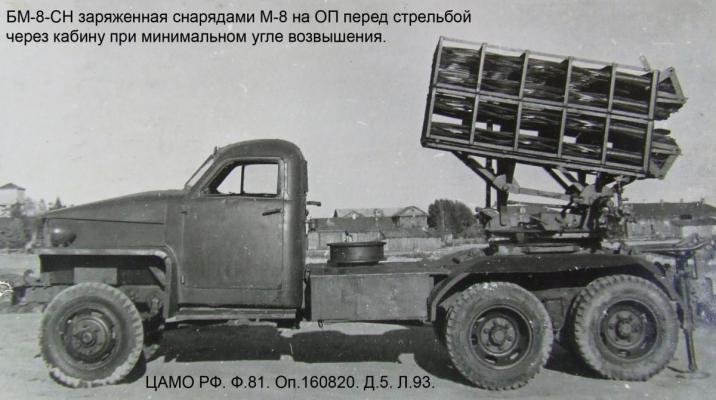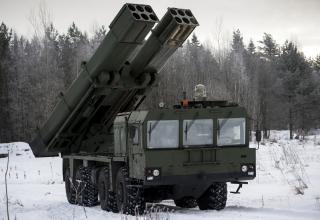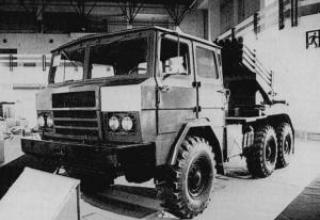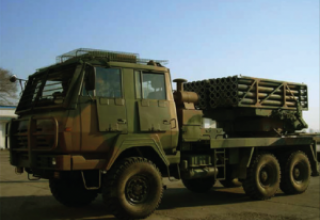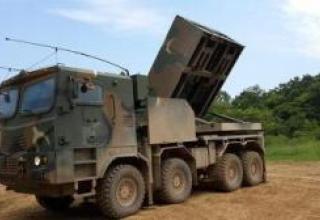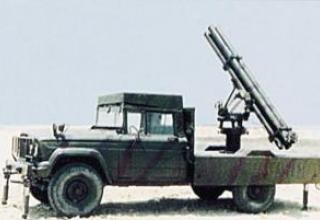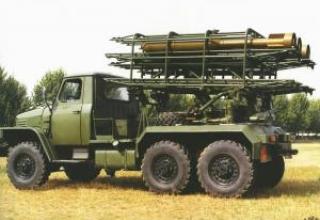The works on creation of a prototype of the BM-8-SN combat vehicle with spiral guides for firing of the M-8 unguided rockets were started in the middle of 1944 in the SKB at the "Compressor" plant (plant No.733 of the NKMV-Narkomat of Mortar Weapons), after the positive experience with the prototype of the BM-13-SN combat vehicle. The main purpose of the work was to increase the pile-up rate of fire.
At the end of April - beginning of May 1945 the first version of the new combat vehicle was tested. According to the results of these tests, the pileup of M-8 rounds increased by 4-11 times. However, a number of serious shortcomings in the design of the vehicle were also identified, which were proposed to be eliminated.
Repeated polygon tests of BM-8-SN combat vehicles designed by plant No. 733 NKMV were carried out in the period from December 10 to December 26, 1945 on the basis of the order of the People's Commissar of Mortar Weapons of the USSR, Colonel-General of Engineering Service Parshin P.I. and Red Army Artillery Commander, Chief Artillery Marshal Voronov N.N. No. 297/072 of December 7, 1945. (see gallery)
The purpose of the repeated polygon tests was
- Definition of tactical, technical and operational qualities of BM-8-SN
- Identification of structural, ballistic and operational advantages of BM-8-SN as compared to standard BM-8-48, as well as comparison with the first variant of BM-8-SN. Feasibility check of the changes made.
- Obtaining a conclusion on the expediency of a series of BM-8-SN combat vehicles for military testing.
The Commission, having acquainted itself with the results of the first BM-8-SN polygon tests and the changes made after the tests, carried out technical inspection, measurement and weighing of 3 BM-8-SN experimental combat vehicles No. 1, 2 and 3, their shooting test for pistols' heap and survivability, as well as mileage test of 2 vehicles No. 1 and 2.
The first version of the BM-8-CH combat vehicle had a number of significant drawbacks, which were eliminated on the tested combat vehicles as described below:
| Flaws detected in the first polygon tests | Degree of elimination of deficiencies in the manufacture of tested samples |
| Rapidly burn contact protrusions of fire pistols. The conductive parts are quickly contaminated with powder soot, the contact heats up. | Pistol pistol pins are made of heat-resistant steel, the dimensions of the parts have been changed to simplify (the thickness of the tube wall is increased from 1.6 to 2.2 mm.). |
| Pirogun tubes burn quickly. | Gaps in the joints of the parts have been modified to eliminate jamming in case of powder soot. The trigger spring has been strengthened. |
|
The base of the combat vehicle, the pivoting frame and the marching parts used without any changes from the standard BM-8-48, were not strong enough, when the vehicle is moving, they are destroyed. |
Two devices have been added, by means of which the load in camping position of the combat vehicle is transferred to the subframe, and the swivel frame and mechanisms are released from the load. Superfluous fixing parts were eliminated during walking. |
| There were chassis spar breakages because all the load is concentrated on the rear axle of the machine, and the center of gravity of the artillery unit is 200 mm higher than the standard one. | For load dispersal - extended subframe by welding additional frames on both sides. The result is a welded construction of three frames. |
| Steamed fire control unit does not provide reliability and convenience of work, overloads the cabin, very heavy, its mounting is broken. |
The control unit was supplied from standard combat vehicles, which meets the requirements of operation. At the same time, two projectiles descend simultaneously from the rails, which is quite acceptable. Electrical wiring has been changed accordingly. It should be noted that the simultaneous launch of two projectiles (paired launch) is currently provided by the TOS-1 and TOS-1A heavy machine guns. |
| MP-41 sight does not provide aiming accuracy and convenience of operation. | The ZIS-3 panoramic sight was delivered, the sighting console was changed accordingly. |
On the basis of Directive No. 348212ss of 5.4.46 of the Deputy Commander of the Artillery of the Armed Forces, military tests of BM-8-SN combat vehicles and repeated military tests of BM-13-SN combat vehicles were carried out in the Sofrinsky art polygon from May 10 to June 10, 1946 (see gallery). The tests were conducted under the chairmanship of the Head of the 6th Faculty of the Artillery Academy, Lieutenant-General of Artillery Kuleshov P.N. A division of the 22nd Separate Guards Mortar Regiment of the Polotsk Red Banner Regiment was assigned to provide military testing. Four combat vehicles BM-8-SN and BM-13-SN of the design and manufacture of plant № 733 MMiP were tested. Firing and mileage tests on combat vehicles were conducted in parallel with regular BM-8-48 and BM-13 combat vehicles.
During the military tests, the following combat firing was carried out with the following tasks:
- Direct-fire from a single combat vehicle (BM-8-CN and BM-13-CN) at an elevation angle of 6°-7° and 10°-10° to determine the smallest angle of sight, which ensures the safety of numbers and the smallest angle of sight when shooting through the cab (4 firing);
- firing of one combat vehicle (new and standard) to determine the heaviest range (elevation angle - 45°) and medium range (elevation angle 21° - only for BM-13-CN) - 21 shots in total.
- battery-powered firing from new and standard combat vehicles to determine the dispersion area and density of battery volley fire (16 firings).
The results of the military tests:
During the BM-8-CN test, firing was established:
- When shooting with direct fire from BM-8-CN, the smallest angle of sight, which ensures the safety of firing from the board, was an angle of 5-6°, with the more likely deviation of Vd and Vb was 2.5 times less than that of the standard BM-8-48 and the gaps were no closer than 200 m from the combat position.
- The scattering area of one BM-8-CN at the maximum range at an elevation angle of 45 degrees was 2.5 times smaller than that of the standard BM-8-48.
- The BM-8-CN battery salvo dispersion area is 4 times smaller than that of the standard BM-8-48, and the battery salvo fire density is 2.5 times higher due to the better heap, despite the fact that the BM-8-CN has 16 smaller guides (barrels) than that of the standard BM-8-48.
- Shrapnel effectiveness of the M-8 projectile on open live targets is satisfactory.
- When firing the new BM-8-CH shells, the TS-34 (issue No. 5) can be used temporarily only for the purpose of choosing the sight setting, since the ranges of fire from both machines are the same.
- When firing, there was a significant number of spikes of M-8 projectiles from the rails, which reached 45% in one of the battery volleys.
The main shortcomings of the BM-8-SN were identified:
- pyrogun trigger was not fixed in the rearmost position and was inconvenient to work with;
- inconvenience in aligning the sights (difficult access to the reference points, no risks on the sights and barrel cuts, no reference level);
- high forces on the swing and lifting handles and uncomfortable positioning of the handwheels;
- low vertical alignment speed;
- inconvenient cleaning and lubrication of the screw guides located in the center of the package;
- discharging of BM-8-CH is less convenient than standard BM-8-48;
- replacement of the damaged barrel in the cassette required replacement of the whole package in the workshop part.
In the process of military testing BM-8-SN proved to be strong and stable in firing and campaigning. The BM-8-SN had an unquestionable advantage in terms of the heap of fire as compared to the BM-8-48 and was recommended for adoption after the technical and main operational shortcomings had been eliminated. It was considered necessary to work on reducing the number of M-8 spikes from BM-8-CN guided combat vehicles.
Composition:
The BM-8-SN combat vehicle intended for firing 82-mm M-8 rockets consisted of an artillery unit and a specially equipped chassis of the "Studebaker" vehicle.
The artillery part consisted of:
- a set of rails with pistols;
- trusses;
- lifting mechanism;
- tilting device;
- swivel mechanism;
- bases;
- electrical equipment;
- sighting equipment.
The said combat vehicle, with the exception of a set of guides with pyro-pistols and a farm, included units from combat vehicles BM-8-48, indexes 52-U-926 and 52-U-927, which were in service with the Red Army Guards mortar units.
In order to address the shortcomings of the first BM-8-CN version, a number of changes were made to the second version, as described below.
The set of guides included 32 spiral guides for firing an 82 mm M-8 rocket projectile. Each guide (barrel) consisted of three round bars and one I-bar, with a groove for the projectile's leading pin, curved along a spiral line with a twist of 307º30" on a length of 2050 mm. The bar and rod were arranged so that they formed a cylinder with a diameter of 82.1mm. In the specified position, the bars were joined together using 6 round cages with electrically welded feet.
In the breech face of the guide, a lock was placed in the groove of the guide rod, holding the projectile in the guide before firing and during movement. The rear pin of the projectile, while moving along the groove of the guide rod, informed the projectile of rotation.
The eight guides welded into the frame were a cassette, four bolted cassettes on the farm - a set of guides. The rear frames of the cassettes were hinged to the folding frames of the pistols, with locks fixing them in the combat position. With the help of pyrotechnic pistols with enclosed pyropatrons the ignition of reactive charge was carried out at firing.
The farm was a platform on which tapes were attached. The farm was connected to a lifting mechanism.
A switch was mounted in the cab, which successively supplied current from the batteries to the fire pistols. During one turn of the switch handwheel current was simultaneously supplied to two pyro-pistols, and therefore, two projectiles could be fired simultaneously and in volley, firing 32 projectiles in 7-10 seconds (depending on the speed of the switchwheel).
BM-8-SN allowed to fire through the cab (without digging the forward) at the lowest elevation angle of 12-13º, which corresponded to the range of about 2600 meters (with the angle of target location equal to 0º). The safety of firing through the cab was ensured by a mechanical interlocking device, limiting the required minimum elevation angle, while the dangerous sector of the gas jet into the cab was switched off by the electric interlock and limited by the external lock.
The base of the standard combat vehicle BM-8-48 before mounting a new farm and a set of spiral guides on it, was subjected to the following changes: the base frame was extended, special plates (front and rear) were welded to the frame to fix the farm with a set of spiral guides in a camping position directly to the frame, thus unloading the swivel device.
The BM-8-SN fighting vehicle was equipped with the ZIS-3 sight with a Hertz panorama. In the rear of the combat vehicle there were hinged jacks. The ZIP had a bannic for cleaning the barrels - rails.
Characteristics:
| Tactical, technical and operational data | ||||
| Data | BM-8-SN experimental with the basis of the index 52-U-926 | BM-8-SN of the first variant with the base index 52-U-926 | BM-8-SN experimental first variant with the base index 52-U-927 | BM-8-SN experimental first variant with the base index 52-U-927 |
| Number of guides | 32 | 32 | 32 | 32 |
| Used projectile | М-8 | М-8 | М-8 | М-8 |
| Guide lengths, m | 2 | 2 | 2 | 2 |
| Type of guide | spiral | spiral | spiral | spiral |
| Minimum elevation angle, ° | -3 | -3 | -3 | -3 |
| Maximum elevation angle, ° | 47 | 47 | 58 | 58 |
| Angle of horizontal guidance, ° | 260 | 260 | 260 | 260 |
| Minimum elevation angle when firing through the cabin, ° | 13 | 13 | 13 | 13 |
| Hoist handle force, kg | 7 | 8 | 8 | 6 |
| Turning handle force, kg | 6 | 5 | 3 | 5 |
| Elevation angle in hiking position | 5°30' | 5°30' | 10°30' | 10°30' |
| The time it takes to charge a combat vehicle, min. | 5-8 | 5-8 | 5-8 | 5-8 |
| Number of projectiles fired at one turn of the switch handwheel | 2 | 1 | 2 | 1 |
| Overall dimensions in camping position, mm: | ||||
| length | 6600 | 6600 | 6340 | 6340 |
| altitude | 3000 | 3000 | 3100 | 3100 |
| width | 2175 | 2175 | 2175 | 2175 |
| Weight of complete guideway set as assembled, kg | 800 | 800 | 800 | 800 |
| Weight of the entire artillery unit with a guide package without chassis, kg | 2360 | 2100 | 2580 | 2170 |
| Also with a set of shells, kg. | 2625 | 2365 | 2795 | 2435 |
| Chassis weight Studebaker without bodywork with two full-drive axles, spare wheel and two Red Army, kg | 3636 | 3636 | 3636 | 3636 |
| Weight of combat vehicle assembled with full refueling, spare wheel and two Red Army men, kg | 6000 | 5750 | 6170 | 5820 |
| It's also loaded, kg. | 6190 | 6035 | 6865 | 6115 |
| Rear axle load of combat vehicle without shells, kg | 4250 | 4050 | 4265 | 4100 |
| Also on the front axle, kg | 1750 | 1700 | 1900 | 1720 |
| Rear axle load in loaded condition, kg | 4460 | 4300 | 4475 | 4350 |
| Also on the front axle, kg | 1750 | 1730 | 1890 | 1760 |
| Position of the centre of gravity of the oscillating part relative to its axis of rotation in the charged state when in a walking position, mm: | ||||
| towards the guide lengths | 380 | 380 | 380 | 380 |
| perpendicular to length | 736 | 740 | 736 | 740 |
| It's also uncharged: | ||||
| towards the guide lengths | 520 | 520 | 520 | 520 |
| perpendicular to length | 717 | 722 | 717 | 722 |
Testing:
The first launches of K-10 in marine aviation were made by North Sea crews on the Caspian Sea in July 1960. Having departed from the airfield of the 33rd Center near Nikolaev, a pair of Tu-16K-10s reached the target, and from a height of 10,000 m at a range of 175 km the crew of Colonel Myznikov made the launch. Due to a pointing error, the missile did not reach the target, having fallen into the sea at 40 km, the crew of Lieutenant Colonel Kovalev, who followed, attacked from a distance of 170 km, achieving a direct fall into the target - the tanker "Chkalov" drowned in shallow water. Within two weeks, three more attacks were carried out, one of which again failed due to operator's error, and in one missile hit the crest of the wave just 200 m from the ship.
The training and combat launches were accompanied by supervision of industry representatives - nevertheless, the system was accepted with many reservations and required prompt correction of defects. For this purpose, even a special design and technological bureau (SCTB) was organized with participation of engineers from MAP, Design Bureau, Research Institute and AUMF. The researches carried out on the basis of the 33rd Center showed the practical feasibility of target detection from 450 km by adjusting the frequencies and length of the radar pulses. It was possible to launch long-range missiles from 325 km, and the lower limit of the aircraft flight was 500-600 m. The radar antenna of the carrier carried out scanning, mechanically rotating through the azimuth of 120 °, making it possible to turn away from the target after launch and continue to provide escort. Usually, the turn-off was performed at the 100th second with a roll of 9-12°, dictated by the possibility of stabilization of the antenna. Approximation to the target, depending on the flight mode and altitude of the launch, did not exceed 140-160 km (later withdrawal from the attack at the start of K-10SD from the maximum range could be carried out at a distance of 265 km).
In one of the departures for tactical launch in 1961, the crew of Captain G.A.Zimin faced an emergency situation, when the missile released into the starting position could not be returned. Nothing good landed with a hanging missile did not promise, because with a normal landing angle of 8 °, there was a great risk of "combing" the missile on the ground. Nevertheless, the crew managed to get the plane to land successfully, and then the instructions for such a case were introduced in the pilot's instructions.
In 1960-62, the K-10 missile system was equipped with seven air regiments of all Soviet fleets: 2nd MRAD of the Black Sea, 5th MRAD of the North, 25th and 143rd MRAD of the Pacific and 57th MRAD of the Red Banner Baltic Fleet. The intensity of development and combat training of maritime aviation crews looked impressive: for the first six months of operation in 1960 there were 79 launches, the next - 126, and in 1962 - 147 (however, the reverse side was a large consumption of combat missiles, and a duplicate aircraft like "Kometa", which allows you to save money and expensive products, for the K-10 was not available).
Another shortcoming was revealed - poor preparedness of ground services for operation of complex equipment. At first, it was assigned to a special engineering and aviation service of SIS, and the issues of warehousing, engaged in repair and maintenance base. Getting rid of duplication of work, the structure was reorganized and introduced a division of responsibilities: all systems of the aircraft were serviced by IAS specialists regiment, and the full list of work on missiles was carried out by the maintenance base.
The measures taken allowed reducing the time of equipment preparation and improving the quality of work. The confirmation was the reduction of the number of unsuccessful launches due to mistakes in the preparation of the mattress - already in 1962, their number decreased by 20%. Near the aircraft were equipped with shelters, where there were refueled and equipped with missiles, pre-tested and flying in the air on "its" carrier. The procedure of suspension and preparation of K-10 was reduced to 45 minutes, and this work was fully carried out by regimental technicians and crews - preparation for the departure of two squadrons with 16 Tu-16K-10 reduced in time by half.
We managed to reduce the number of failures, although the number of complaints about the shortcomings and defects of the system remained tangible, so the reliability of the Tu-16K-10 was inferior to other, simpler complexes, primarily through the fault of the equipment. In 1961, almost half of the completed launches failed, and about a third - due to design and manufacturing flaws.
Face-to-face with Soviet missile carriers, the United NATO Fleet had to meet in September 1964 during a major exercise "Tim Work-64", covering the entire North Atlantic. More than half a dozen ships, including two aircraft carrier groups, participated. The squadron was discovered by Tu-95 reconnaissance aircraft of the Northern Fleet, after which the command of the 5th MRAD offered to organize a response exercise with the use of aviation "on real targets", showing, for example, the head of the country to the Americans "Kuzkinu mother". Command of the Navy, however, was afraid of bringing the situation to the brink of unleashing a real war, but the top leadership of the country gave the conceived "good".
By order of the Air Force Headquarters of the NF plan was adopted for implementation. In the evening of September 21, three squadrons of Tu-16K-10 strike team of Lieutenant Colonel KL Timakov, as well as scouts, designators and interference operators who were covering the missile carriers. The ship's group was found in the ocean, the planes at low altitude stealthily reached the border of the attack. The "missile strike" was launched from three directions with a distance of 160-200 km, and the enemy was helpless to repel it.
At TOF in 1964 there was a case of attack K-10S Japanese ship, which was in the restricted zone of the range. Shino-Maru" was held near Cape Tyk, where the crew of Tu-16K-10 from the 169th MRAP worked out a training task. Having refocused, the rocket went exactly on a new "target". The Japanese were lucky - the fuse was set to detonate on the trajectory to save the targets, and the explosion occurred 400 meters from the board. The wreckage damaged the superstructure and the rocket's engine broke through the ship. Among the crew were wounded, which forced the Japanese to go to the nearest Soviet port of Kholmsk for medical care and repair. The incident managed to jam, and the Japanese side believed that the ship was hit by a crashed Soviet fighter, and expressed sympathy for the lost pilot.
During the largest strategic exercise "Ocean", held in April 1970 and covering all the fleets and water areas, the North Sea Tu-16K carried out 6 rocket launches at the range, thrown into reinforcements to them 10 missile carriers with TOF April 20 attacked the target missiles near the Kola Peninsula. Nine Tu-16K-10 of the Pacific 143rd MRAD, supported by five tankers, carried out tactical attacks in the Sea of Japan, using groups of NATO and U.S. ships as targets.
The Baltfleet's Tu-16K-10 was airborne when it intercepted the mutinous SCR "Storozheva," which left the base and headed for the Strait of Irben during the October 1975 holidays. It was supposed that he wanted to go abroad, and to stop this attempt on November 8 and 9 all forces of the fleet and aviation were alerted. Rocket attack in the area with busy shipping, fortunately, did not take place - Tu-16 found the target when the ship has already been bombed and stalled cars, but they accompanied him on the way back to the base.
With the organization of the base of the Soviet fleet in the Vietnamese port of Kamran there was placed 169th gv. SAP, which, in addition to scouts, target designation and anti-submarine aircraft, at the front positions was a squadron of Tu-16K-10-26. They served there from 1982 to 1989.
Sources:
- Ракетные пусковые установки в Великой Отечественной войне. О работе в годы войны СКБ при московском заводе “Компрессор”. // А.Н. Васильев, В.П. Михайлов. – М.: Наука, 1991. – С. 80–81.
- ЦАМО РФ. Ф.81. Оп.160820. Д.5. ЛЛ.2-10,13-19,37-39,46,47,51,52,55-58,93.
- ЦАМО РФ. Ф.81. Оп.160820с. Д.4. ЛЛ.31-37.
